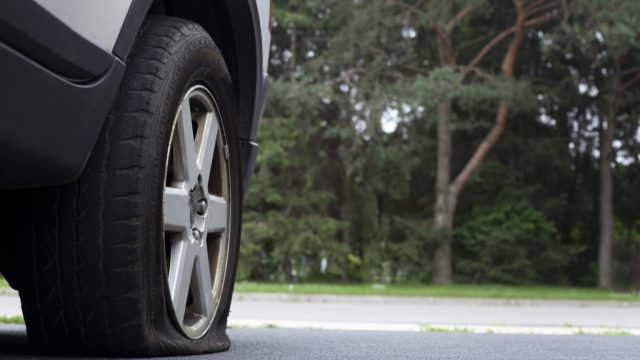This Is the Safest Way to Change a Flat Tire

Tire blowouts often feel as though they occur out of nowhere. However, research by the National Highway Traffic Safety Administration (NHTSA) reveals that there are often detectable warning signs and actions we can take to avoid getting a flat on the road. Considering that the NHTSA attributes over 400 vehicular deaths and 78,000 accidents to blowouts every year, the absolute safest way to change a tire is to do it before it becomes a problem while driving.
As reported in their 2012 study, “the data shows that of all the vehicles that had prior tire damage to one or more of their tires, 31.6 percent experienced tire problems [on the road] and about 68.4 percent did not experience tire problems. On the other hand, among vehicles with no prior tire damage, only 4.5 percent were tire-related crash vehicles.” This indicates that if you do have tire damage (regardless of whether you are aware of it or not) you can reduce your chances of an accident significantly by simply having your tires regularly inspected and serviced. Be sure to go in promptly for a check up if you notice any of these warning signs.
Of course, we can’t anticipate all blowouts so it’s good to be prepared; be sure that at all times, your car has the tools you need to fix a tire. According to the Department of Motor Vehicles, the trunk of your car should contain a lug wrench, a jack, a working flashlight, flares and reflective triangles, leather gloves, wheel wedges, a spare tire, and a tire replacement kit. Tire company Bridgestone also recommends stashing away some rain gear, as well as a 2×6 piece of wood to secure the jack. It is imperative that you know where everything is located, and how to actually use each tool if you intend to attempt a tire change yourself. Fumbling around‒possibly at night or in poor weather conditions‒is an unsafe start.
If you find that a tire change is unavoidable on the road, pulling over safely is your first order of business. Slow down and put your hazards on, driving as far away from traffic as possible—ideally to somewhere paved and flat. Next, put on your parking brake and use your flares, if necessary. When you get out of the car, put wheel wedges or a similar rolling deterrent, like a brick or piece of wood, in front of your car’s tires. Next, you’ll want to remove your car’s hubcap, loosen the lug nuts without removing them, position the jack, then raise your car using the aforementioned piece of wood for stability. Once the car is raised, remove the lug nuts and the flat, put the spare tire on, and tighten the lug nuts using only your hand.
Next, you’ll want to bring your car down so that the tire is lightly touching the ground. Use your wrench to tighten the lug nuts. Now, completely lower the vehicle, pull out the jack, and tighten those lug nuts just a bit further with the wrench. Put your hubcap back on, pack up your gear, turn off the hazards and parking break, and you’re good to go.
And finally, if you don’t feel that you’re in a safe enough place to try changing a flat on your own‒whether because of busy traffic or the area itself being isolated or dangerous‒don’t hesitate to stay in your car and call for roadside assistance. The risk is hardly worth it.
To discover more amazing secrets about living your best life, click here to sign up for our FREE daily newsletter!